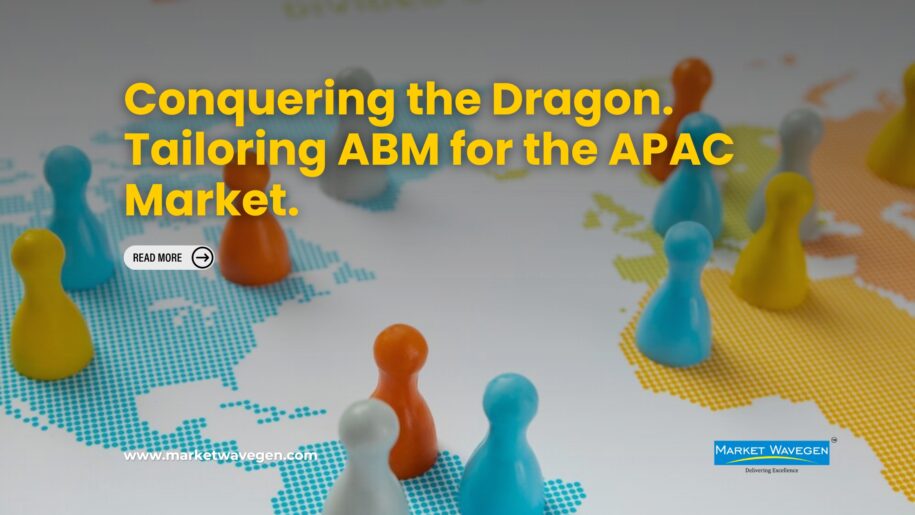Account-Based Marketing (ABM) has taken the B2B world by storm. By focusing on high-value accounts with personalized campaigns, companies are experiencing significant improvements in sales pipeline, ROI, and marketing-sales alignment. But the road to ABM success isn’t a one-size-fits-all journey. The Asia-Pacific (APAC) region, with its diverse cultures, business landscapes, and technological adoption rates, presents unique challenges for implementing ABM. However, these challenges are also opportunities to refine your approach and achieve even greater results.
Challenges of ABM in APAC
- Cultural Nuances: APAC is a mosaic of cultures, each with its own communication styles, decision-making processes, and relationship preferences. Direct, aggressive tactics that might work in Western markets can be perceived as disrespectful in some APAC cultures. Building trust and fostering long-term relationships are paramount.
- Fragmented Landscape: APAC is a geographically vast region with significant economic disparities. Developed economies like Singapore and Australia coexist with emerging markets like India and Vietnam. A one-size-fits-all content strategy won’t resonate across such a diverse landscape. Market research and audience segmentation are crucial for effective targeting.
- Language Barriers: APAC boasts a multitude of languages. While English is widely used in business circles, relying solely on it can alienate potential customers. Consider localizing your messaging and campaigns to resonate with the target audience’s language and cultural preferences.
- Data Availability and Quality: Data privacy regulations and cultural sensitivities can make it difficult to acquire high-quality, comprehensive data on target accounts. This can hinder effective identification, segmentation, and personalization of ABM campaigns.
- Technology Adoption: While APAC is experiencing rapid technological advancements, the pace of adoption varies across the region. Some companies may have limited digital footprints or prefer traditional communication channels. Tailoring your outreach strategy to the target account’s digital maturity is essential.
Overcoming the Challenges: Building Your APAC ABM Strategy
- Deep Market Research: Invest in thorough research to understand the specific cultural nuances, business practices, and communication preferences in your target markets. Leverage local teams or partners to gain valuable insights.
- Account Selection: Be highly selective when choosing target accounts in APAC. Focus on quality over quantity and prioritize companies with the right cultural fit and decision-making structures.
- Segmentation is Key: Don’t treat APAC as a single entity. Segment your target accounts based on factors like location, industry, company size, and digital maturity. This allows for tailored messaging and outreach strategies.
- Embrace Account-Based Storytelling: Facts and figures are important, but stories resonate. Develop compelling narratives that showcase how your solution addresses specific challenges faced by businesses in your target markets. Leverage case studies and testimonials from local customers to build trust and credibility.
- Omnichannel Approach: Integrate traditional and digital marketing channels to reach your target audience effectively. Utilize a mix of emails, social media, events, and even offline channels like direct mail depending on the target account’s preferences.
- Building Relationships: Focus on nurturing long-term relationships with key decision-makers. Participate in industry events, host webinars or workshops, and provide valuable content that addresses their specific needs.
- Data-Driven Personalization: While data availability might be a challenge, leverage the data you do have to personalize your outreach. Use firmographic and technographic data to tailor messaging and identify decision-makers within the target account.
- Invest in Local Teams or Partners: Having a strong understanding of local cultures and business practices is crucial. Consider building an in-house APAC team or partnering with local agencies that can provide valuable expertise and navigate cultural nuances.
- Measure and Refine: Track the performance of your ABM campaigns in APAC. Analyze key metrics like engagement rates, conversion rates, and pipeline velocity. Use these insights to continuously refine your strategy and messaging for better results.
- Embrace Flexibility: The APAC market is dynamic and constantly evolving. Be prepared to adapt your ABM strategy based on market trends, competitor activity, and customer feedback.
Conclusion
ABM presents a powerful opportunity to achieve significant growth in the APAC market. By acknowledging the unique challenges of the region and tailoring your strategy accordingly, you can build lasting relationships with high-value accounts and unlock the full potential of ABM in APAC. Remember, success lies in understanding the cultural landscape, segmenting effectively, personalising your approach, and fostering trust-based relationships.
Ready to unlock the power of ABM in the APAC region? Schedule a free consultation with our experts today to discuss your specific goals and develop a customised ABM strategy for your target markets in APAC.


Leave a Reply